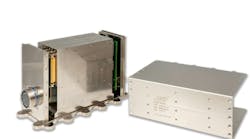FOUNTAIN HILLS, Ariz., 21 March 2013. The military embedded computing industry is stuck temporarily in the economic doldrums because of massive uncertainty over the future U.S. defense budget, federal sequestration, and a 22 percent drop in defense spending during the fourth quarter of 2012, but bad times may not last for long, according to a report released Wednesday.
While revenues from military embedded systems are down for the time being, the industry could see a surge in activity once the fiscal year 2014 Pentagon budget request is issued sometime between now and June, according to the 2013 State of the VITA Technology Industry report released this week.
The report is from the VITA Open Standards, Open Markets embedded computing industry trade association in Fountain Hills, Ariz., and authored by VITA Executive Director Ray Alderman.
Military embedded computing is in a deep economic trough largely because of long-term industry uncertainty and a delayed 2014 budget request. Normally the Pentagon sends its budget request in February, but this year the request could be delayed to as late as June, Alderman says.
The aerospace and defense embedded computing industry remains "in a fog of uncertainty and confusion," Alderman writes. Without some measure of market clarity, which will enable prime contractors to make hiring and budgetary decisions, the industry will remain so.
Furthermore, industry innovations through research, development, and other innovations have become stagnant such that "There is no point in going over promising military applications and technologies" until things change, Alderman says.
Market change, however, could some sooner than some might think, Alderman says. "We have the potential for more military conflicts in the future, not less," he warns. "we will need advanced military systems (intelligence platforms and weapons platforms) in the future. we may need fewer of them, but they must be much more capable of carrying out specific missions than the platforms we have today."
In the VITA Technology Industry report Alderman writes that we live in a post-industrial and post-telecom world, but not in a post-military world. On the contrary, Alderman says, "We live in a pre-military world today."
The most promising aerospace and defense technologies for future advanced radar, sonar, signals intelligence (SIGINT), communications intelligence (COMINT), electronic intelligence (ELINT), and electronic warfare (EW) systems are sensors and optical interconnects, Alderman says.
"Sensor technology is advancing dramatically, creating huge amounts of data to be analyzed," Alderman writes. The problem, he says, is not processing power -- there's plenty of that -- but instead is I/O and system interconnects.
"These processors can handle more data than today's I/O interconnects can deliver in real time," Alderman says. "We must go to optical connections when data rates exceed 10 to 15 gigabits per second in critical embedded systems, and when the advanced processors increase their computing capabilities."
The most recent State of the VITA Technology Industry report -- a document that VITA releases twice a year -- is available online at www.vita.com/home/NewsandEvents/Reports/2013-03%20State%20of%20Industry%20Report.pdf. For more information contact VITA online at www.vita.com.



